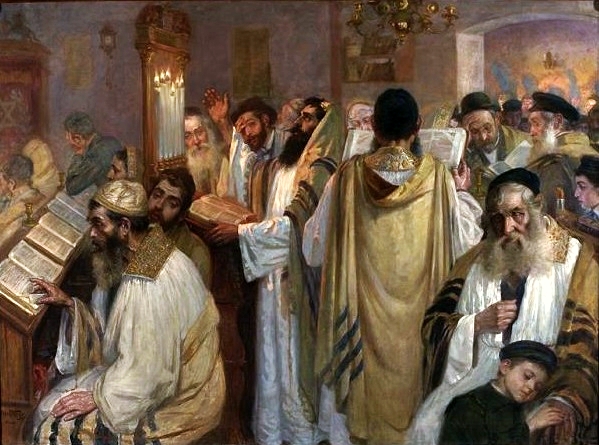Fates are sealed.
Fasts take place.
And a chicken makes an appearance.
Welcome to Yom Kippur, the holiest day of the Jewish year.
- What is Yom Kippur?
- What does Yom Kippur mean?
- What are the origins of Yom Kippur?
- How do you celebrate Yom Kippur? What are the rituals and traditions of Yom Kippur?
- When is Yom Kippur?
What is Yom Kippur?
First and foremost, it is the holiest day of the Jewish year.
It is known as Day of Atonement, and is dedicated to atoning for sins.
Yom Kippur is also the last day of the Jewish High Holy Days (Days of Awe).
It takes place on the tenth day of Tishrei (that is, the tenth day of the seventh month of the Hebrew calendar) – 10 days after Rosh Hashanah. Usually it means that it takes place during September or October.
What does Yom Kippur mean?
On Yom Kippur, the fate of each person is sealed in one of the three books of account that are opened on the Jewish New Year, Rosh Hashanah (which is the first day of the Jewish High Holy Days).
Each person is recorded in one of these books by their deeds – the wicked, the righteous, and those of the intermediate class.
The names of the righteous are immediately inscribed in the book of life and they are sealed “to live” in the coming year. The wicked are forever banned from the book of the living, and are condemned to death in the coming year. Yikes.
The intermediate class are given ten days (the days between Rosh Hashanah and Yom Kippur) to reflect, repent and become righteous.
So Yom Kippur is of the utmost importance, as fates are sealed on this day.

What are the origins of Yom Kippur?
The Book of Leviticus is the third book of the Torah (the Hebrew Bible). It references the tenth day of the seventh month of the Hebrew calendar twice.
In Leviticus 16:1–34, on the tenth day of the seventh month, God said that the people must not work in order to cleanse and atone for their sins. The Kohen (the Jewish priest) will lead in the atonement of all the people.
In Leviticus 23:26–32, God said to Moses that the tenth day of the seventh month is the day of atonement and will be holy. The people must give a fire-offering to God and must not work. God continues to tell Moses that whoever does work, God will rid of the soul from its people. This is a day of complete rest from the evening of the ninth day of the month to the following evening. (As you may remember, in Judaism the day starts in the evening)
A day of atoning for sins also appears in Book of Numbers, which is the fourth book of the Hebrew Bible.
In Numbers 29:7-11, the Hebrews are instructed to make offerings for their sins, to make atonement for them and to afflict their souls.
How do you celebrate Yom Kippur? What are the rituals and traditions of Yom Kippur?
On the day before Yom Kippur, penitential poems and prayers are added to the morning service. Other rituals include asking others for forgiveness and giving charity.
A controversial ritual that happens the day before Yom Kippur is Kapparot (Hebrew for “atonements”). It is a customary atonement ritual, in which a chicken is waved over a person’s head. Then, the chicken is slaughtered and donated as charity.
The chicken represents an exchange or substitute for the person, to be their atonements.
In modern times though, the chicken is replaced with a bag of money. So a bag of money is waved over a person’s head and is then donated as charity, and no animals are harmed during the process. Yay!
Then, we move on to Yom Kippur.
The most prominent ritual is prayer. Lots and lots of prayer.
A regular day has three prayer services. And on the Day of Atonement? Well it has five prayer services. The special prayer services also include confessions of sins (private or public confessions). After the last prayer of the day, a single blast is blown on the shofar.
Another custom is fasting – there is no eating and drinking allowed starting the sunset before Yom Kippur and ending the sunset on Yom Kippur.
Other prohibitions include no wearing of leather shoes, no bathing nor washing, no anointing oneself with perfumes nor lotions and no marital relations.
In Israel there is one more custom – everybody refrains from using their cars. No traffic on the roads means one thing – tens of thousands of people ride their bicycles on the streets! Kids, youths, and families dust off their bikes (or buy new ones) and set off on tarmac adventures. It’s a rare chance to ride freely and safely right in the middle of the road – including on the highways!
And after Yom Kippur ends and a light meal is eaten after the fast, there is one last custom.
The Jewish immediately begin construction of the sukkah.
What is a sukkah and what is it used for? Find out in our next post, as it is used in the very next holiday – Sukkot.
When is Yom Kippur?
2021 – begins in the evening of Wednesday, 15 September and ends in the evening of Thursday, 16 September
2022 – begins in the evening of Tuesday, 4 October and ends in the evening of Wednesday, 5 October
2023 – begins in the evening of Sunday, 24 September and ends in the evening of Monday, 25 September
2024 – begins in the evening of Friday, 11 October and ends in the evening of Saturday, 12 October
2025 – begins in the evening of Wednesday, 1 October and ends in the evening of Thursday, 2 October

